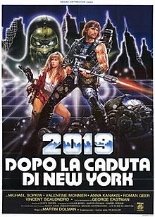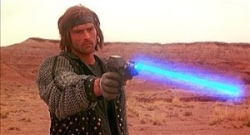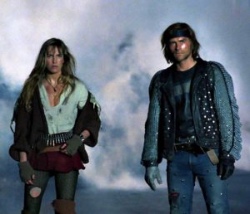
 How does one earn the ceremonial title of Queen of the Jungle? In 15 minutes or less, Sheena shows us: by having your geologist parents be killed by falling rocks while searching for the source of the fabled “healing earth” in a primitive African village.
How does one earn the ceremonial title of Queen of the Jungle? In 15 minutes or less, Sheena shows us: by having your geologist parents be killed by falling rocks while searching for the source of the fabled “healing earth” in a primitive African village.
Okay, so it’s a little more complicated than that, but that little white blonde grows up to be the zebra-riding, hedgehog-summoning, lion-ordering, vine-swinging, breast-bouncing leader of the Zambuli tribe. One credit sequence later, she’s bathing full-frontal nude under a waterfall — not just in broad daylight, but played by Tanya Roberts in her Bond-girl prime, her eyes both sultry and vacant. She looks like she’s auditioning for the part of Eve in Playboy’s The Bible.
 Her quiet existence is upended when Sports World journalist Vic Casey (a bland Ted Wass, Curse of the Pink Panther) and rotund cameraman Fletcher (Police Academy vet Donovan Scott) fly to Africa to shoot a segment about the football glory days of Prince Otwani (Trevor Thomas, Inseminoid). A royal assassination occurs, and the patsy for it is the Zambuli shaman (Elizabeth of Toro), whom Sheena has on telepathic speed dial.
Her quiet existence is upended when Sports World journalist Vic Casey (a bland Ted Wass, Curse of the Pink Panther) and rotund cameraman Fletcher (Police Academy vet Donovan Scott) fly to Africa to shoot a segment about the football glory days of Prince Otwani (Trevor Thomas, Inseminoid). A royal assassination occurs, and the patsy for it is the Zambuli shaman (Elizabeth of Toro), whom Sheena has on telepathic speed dial.
Sheena tries to keep the peace and protect her land. Vic tries to tap that.
If there’s one thing kids love in live-action adaptations of comics, especially ones they have no familiarity with, it’s warring political factions, right? This nonsense is like quicksand to Sheena’s pacing; there’s simply not enough of the Tarzan-style action and adventure present in the Will Eisner-created comic book and 1950s TV series. What little exists is supremely silly, with Sheena leading all creatures great and small in some sort of jungle-based Justice League (for which a rule against public defecation presumably has been waived), culminating in an elephant destroying a helicopter.
 Whereas 2017’s Wonder Woman sees its heroine as empowerment embodied, Sheena sees its as merely a body. Even if Roberts’ nude scenes were excised, that still would leave all the leering shots up her loincloth, with John Guillermin reusing low angles from his ’76 King Kong as she climbs — which is often. (The nudity is something of a miracle for a PG-rated film, especially since the PG-13 was a month old.)
Whereas 2017’s Wonder Woman sees its heroine as empowerment embodied, Sheena sees its as merely a body. Even if Roberts’ nude scenes were excised, that still would leave all the leering shots up her loincloth, with John Guillermin reusing low angles from his ’76 King Kong as she climbs — which is often. (The nudity is something of a miracle for a PG-rated film, especially since the PG-13 was a month old.)
Sheena is also rather dumb, because when Vic first kisses her, she says, “Mouths were given us to eat with. Why did you touch yours to mine?” And that raises a Big Question: Does she brush and floss? It’s a valid inquiry, given her diet of “locust bean cakes” and “fermented buffalo milk.”
This claptrap goes on and on for two hours. If the natives are restless, think how you will feel. —Rod Lott


 As the son of an abusive backwater prostitute, Wheeler (John King III,
As the son of an abusive backwater prostitute, Wheeler (John King III, 

 The year is 2019. America is under the rule of a tyrannical despot that will, without mercy, capture and kill those who don’t meet his idea of genetic perfection simply to attain his primarily dark goals of world domination. No, it’s not the long-awaited Donald Trump biopic — give it a few years, though — instead, it’s the
The year is 2019. America is under the rule of a tyrannical despot that will, without mercy, capture and kill those who don’t meet his idea of genetic perfection simply to attain his primarily dark goals of world domination. No, it’s not the long-awaited Donald Trump biopic — give it a few years, though — instead, it’s the 


 To celebrate high school graduation, four couples have concocted an utterly monstrous, mind-roasting plan: to spend the night in a furniture store. And not just any furniture store, but Fine Furniture downtown, whoa-ho! John (Sean Kanan,
To celebrate high school graduation, four couples have concocted an utterly monstrous, mind-roasting plan: to spend the night in a furniture store. And not just any furniture store, but Fine Furniture downtown, whoa-ho! John (Sean Kanan, 

